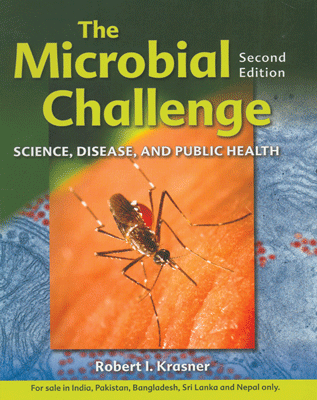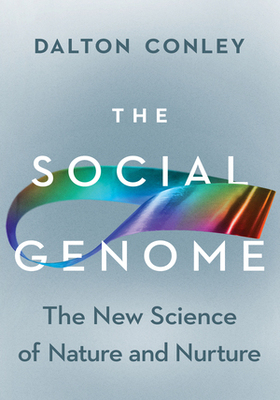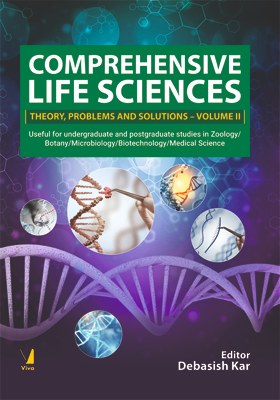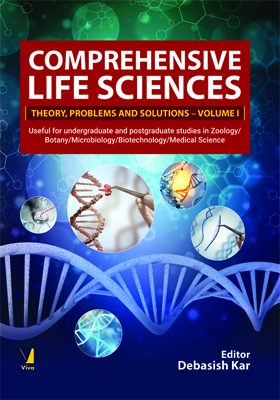The Microbial Challenge, 2/e
The Microbial Challenge, 2/e
Science, Disease and Public Health
₹625.50 ₹695.00 Save: ₹69.50 (10%)
Go to cartISBN: 9789380108292
Bind: Paperback
Year: 2010
Pages: 496
Size: 7.75 x 9.75 Inch
Publisher: Jones & Bartlett Learning
Published in India by: Jones & Bartlett India
Exclusive Distributors: Viva Books
Sales Territory: India, Nepal, Pakistan, Bangladesh, Sri Lanka
Description:
Whether we realize it or not, microbes play an ever-present role in our daily lives. Foodborne infections, epidemics and pandemics are frequently headline news. The Microbial Challenge: Science, Disease and Public Health, Second Edition, presents a fascinating look at human-microbe interactions and examines the disease producers while discussing how, with knowledge-based preparation, we can live in harmony with microbes. It also discusses the ways in which beneficial microbes are involved in the cycles of nature and in the food industry, and how they are used as research tools. Ideal for undergraduate nonscience majors and allied and public health students, this unique text is a hybrid of microbiology and public health and includes material on prions, helminths (worms), biological warfare and terrorism, antibiotic resistance, the global impact of microbial diseases, and immunization. The text helps students better understand the biology of the microbial world and the societal factors that are both the cause and consequences of microbial disease.
New and key features of the second edition:
- All chapters have been updated, revised and streamlined to improve the overall flow of information and aid in student comprehension and retention.
- A new Chapter 6, Bacterial Genetics, reviews basic genetics and moves on the focus on transformation, conjugation and transduction as strategies of genetic exchange in bacteria.
- The latest epidemiological data, new information on antibiotic resistance, and current discussions on new emerging diseases are included.
- A new design and art program allows students to focus more sharply on important concepts.
Target Audience:
A microbiology course for non-biology majors. Ideal for undergraduate non-science majors and allied and public health students, this unique text is a hybrid of microbiology and public health.
Contents:
Part 1: The challenge
Chapter 1: Identifying the Challenge • The challenge • Factors responsible for emerging infections • World population growth • Urbanization • Ecological Disturbances • Technological Advances • Microbial evolution and adaptation • Human behaviour and attitudes
Chapter 2: The Microbial World • Some basic biological principles • Cell theory • Metabolic diversity • Requirement for oxygen • Genetic information • What makes a microbe? • Procaryotic and eucaryotic cells • Microbial evolution and diversity • Introducing the microbes • Prions • Viruses • Bacteria • Protozoans • Fungi
Chapter 3: The Beneficial Aspects of Microbes: The other side of the coin • Microbes in the environment • Microbes as decomposers • Microbes and the biogeochemical cycles • Microbes in food production • Bread products • Dairy products • Wine, beer and other alcoholic beverages • Harnessing microbes as research tools • Harnessing microbes in industry • Harnessing Microbes for bioremediation • Sewage and waste water treatment
Chapter 4: Bacteria • Cell shapes and patterns • Naming bacteria • Anatomy of the bacterial cell • Envelope • Cytoplasm • Appendages • Bacterial growth • Lag phase • Exponential (Logarithmic) Phase • Stationary phase • Death phase • Significance of bacterial growth • Culturing Bacterial: Diagnostics • Oddball (atypical) bacteria • Mycoplasmas • Chlamydiae • Rickettsiae
Chapter 5: Viruses • Viruses as infectious agents • Virus structure • Nucleic acids • Protein coat • Viral envelopes • Viral classification • Viral replication • Adsorption • Penetration • Replication • Assembly • Release • Host cell damage • Cultivation (growth) of viruses • Embryonated (fertile) chicken eggs • Cell culture • Diagnosis of viral infection • Phage therapy
Chapter 6: Bacterial Genetics • DNA structure • DNA replication • Proof of DNA as the genetic material • Transcription: DNA to mRNA • Translation: mRNA to protein • Gene expression • Bacterial genetics • Mutations • Recombination • Transformation • Transduction • Conjugation
Part 2: Microbial Disease
Chapter 7: Concepts of Microbial Disease • Biological associations • Parasitism: A way of life • Microbes as agents of disease • Microbial mechanisms of disease • Pathogencity and virulence • Defensive strategies • Offensive strategies: Extracellular products • Virulence mechanisms of nonbacterial pathogens • Stages of a Microbial disease • Incubation stage • Prodromal stage • Illness stage • Stage of decline • Convalescence stage
Chapter 8: Epidemiology and Cycle of Microbial Disease • Concepts of epidemiology • Cycle of microbial diseases • Reservoirs of infection • Transmission • Portals of entry • Portals of exit • Nosocomial (Hospital- Acquired) Infections • Hospital environment as a source of nosocomial infections • Control measures • Epidemiology of fear
Chapter 9: Bacterial Diseases: Foodbornes and waterborne bacterial diseases • Food intoxication ( food poisoning) • Foodborne and waterborne infection • Airborne bacterial disease: Upper respiratory tract infections • Lower respiratory tract infections • Sexually transmitted diseases: Syphilis • Gonorrhea • Chlamydia • Lymphogranuloma Venereum and Haemophilus ducreyi disease • Contact diseases (other than STDs) • Peptic ulcers • Leprosy • Staphylococcal infections • Arthopodborne diseases • Plague • Ehrlichiosis • Lyme Disease • Relapsing fever • Rickettsial diseases
Chapter 10: Viral Diseases • Foodborne and waterborne viral disease • Gastroenteritis • Hepatitis A and E • Poliomyelitis • Airborne Viral diseases: Influenza • Respiratory syncytial virus • Common cold • Measles (Rubeola), Mumps and German Measles ( Rubella) • Chickenpox ( Varicella) and Shingles ( Herpes Zoster) • Hantavirus Pulmonary Syndrome • Severe acute respiratory syndrome • Smallpox • Sexually Transmitted Viral Diseases • Genital Herpes • Genital warts • Contact diseases (Other than Sexually Transmitted Viral Diseases) and Bloodborne Viral Diseases • Infectious mononucleosis • Hepatitis B, C, and D virus • Rabies • Ebola Virus • Arthropodborne diseases • Dengue fever • Yellow fever • Encephalitis- causing Arboviruses
Chapter 11: Protozoans And Helminths and the Diseases they Cause • Biology of protozoans • Protozoan diseases • Foodborne and waterborne diseases • Arthropodborne diseases • Sexually Transmitted Diseases • Biology of Helminths • Helminthic diseases • Foodborne and waterborne diseases • Arthropodborne diseases • Direct contact diseases • Transmission of worms from pets
Part 3: Meeting the Challenge
Chapter 12: The Immune Response • Basic concepts: Anatomy and physiology of the body's defenses; Mechanical and chemical barriers; blood; lymphatic system; Primary immune structures; Secondary immune structures • Duality of immune function: Nonspecific and specific immunity; Nonspecific immunity; Specific immunity • Clinical correlates; Human immunodeficiency virus • Leukemia
Chapter 13: Control of Microbial Diseases • Sanitation and clean water; development of sanitation; Human waste disposal; clean water • Food safety • Immunization • Active immunization; Types of active artificial vaccines ; Passive immunization; Vaccine safety; Childhood immunization • Antibiotics; History of antibiotics • Types of antibiotics • Mechanisms of antimicrobial activity • Acquisition of antibiotic resistance • Mechanisms of antibiotic resistance • Antibiotic misuse • Working toward the solution • Antiviral agents
Chapter 14: Partnerships in the Control of Infectious Diseases: Background • Partnerships in infectious disease control; at the local level; at the national level; at the international level; The private sector; Partnerships: The way to go
Part 4: Current challenges
Chapter 15: Biological Weapons • Biological warfare and terrorism; War and diseases • History of Biological weaponry • Early history to World War II • World War II to 1972 • 1972 to September 11, 2001 • Emergence of biological weaponry • Category A biological effects • In the aftermath of September 11, 2001
Chapter 16: Current Plagues • Nature of plagues • Prions: MCD and variant Creutzfeldt-Jakob disease; Biology of prions; Mad cow disease; Human TSEs; BSE-vCJD Link • Control measures: Breaking the cycle of transmission • AIDS; Biology of HIV; Origin of AIDS; Transmission of AIDS; AIDS: The disease; Cause of AIDS; AIDS treatment and prevention; Consequences of AIDS; AIDS in Africa; AIDS in the United States; The future of AIDS • Tuberculosis • Current status • TB: The disease • Diagnosis • Antibiotic therapy • DOTS • Factors contributing to reemergence • Prevention
Chapter 17: The Unfinished Agenda • Text review • An ongoing battle • Research • Health for all
Glossary • Index
About the author:
Robert Krasner, PhD, MPH - Providence College
Robert Krasner is Professor Emeritus in the Department of Biology at Providence College, having retired in 2008 after 50 years of teaching and research. During his career, he presented many papers in the United States and internationally. He founded the Summer Science Program for high school students in 1975, which he directed for 31 years. Dr Krasner earned a Master of Public Health degree from the Havard School of Public Health in 1999. He is member of the American Society of Microbiology and the American Academy of Microbiology and was instrumental in establishing a division for microbiology education.







